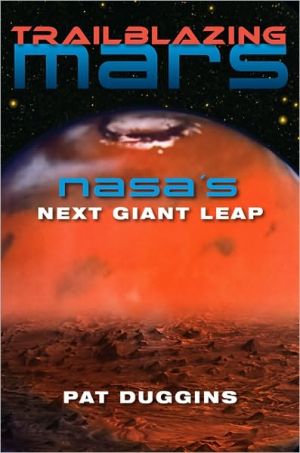

 |

|

The average rating for Trailblazing Mars: NASA's Next Giant Leap based on 2 reviews is 3 stars.
Review # 1 was written on 2011-01-17 00:00:00 Melinda Haner Melinda HanerVery readable survey of NASA's history of exploration of Mars, and aspects of a possible future manned mission. Plainly worded explanations for non-specialists make this book an easily-read review of all significant aspects of a manned mission to Mars, a relevant addition to the literature I have seen on space exploration. Bolstered with relevant pictures and quotes from many astronauts, officials and academics, the writing has the feel of long-form journalism with the right level of detail, and discussions include the engineering, political, administrative and cultural side of each mission and possible mission. Duggans starts with the historic Mariner 4 and Viking missions of the 60s and 70s, then explains the 20+ year gap between the relatively pricey Viking and the relatively cheaper Mars Pathfinder and Mars Polar Lander missions, along with discussion of the shuttle era and its conclusion, and the various eras of NASA and the political forces which have affected its priorities. Especially interesting is his discussion of the various Commissions reviewing NASA's goals, such as the Augustine Commission, and of the Biosphere 2 experiment, and the lessons learned there which would be applicable to a manned mission to Mars. Equally interesting is the discussion of the changing requirements of astronauts - from the test pilots of the early Mercury and Apollo programs, to the space scientists and engineers of the shuttle era. A survey of the astronaut office revealed that the most important person on a manned Mars mission would be the mechanic. Moving onto aspects of a possible manned mission to Mars, the book includes a review of the ongoing scientific debate about possible farming and growing crops in space and on Mars, as well as the debate about the extent to which international cooperation with ESA, Russia and other spacefaring nations might be advantageous to NASA. Additionally, possible sites of scientific interest on Mars are weighted against sites helpful to habitation - such as those with resources which might be used for farming, as a source of water for the crew, and for rocket fuel production. For another view, please see the very excellent Space Review blog: |
Review # 2 was written on 2010-10-09 00:00:00 Patrick Gordon Patrick GordonI was hoping for a straight shot the hard stuff on the latest thinking about the challenges of a manned mission to Mars. Instead I was given a weak cocktail. There is very little that is new or original here. It is mostly a summary of various space missions, manned and unmanned since Sputnik, many of which are only tangentially related to a manned mission to Mars. The book might have better been titled: "The Long Road to Mars'An Historical Summary of Space Missions Inching NASA Slowly Towards the Red Planet." In other words, it's a bit of a bait-and-switch, and I fell for it. The analogy that the author uses in his title as well as throughout the book, that of a manned Mars mission being like the pioneers crossing the West didn't work for me. Pioneers could get out of their wagons away from the dust and breathe fresh air. Anytime they needed energy they could let the oxens graze and they could cut down trees for firewood. There were lots of opportunities to get away from those in your wagon and converse with dozens of others on the trail. It didn't take 2 ½ years to make it from St. Louis to the West Coast. Mars bound astonauts may have an expert physician on board and fantastic communications capabilities, but I think they would all do double back flips if they thought it would be as easy as what the pioneers faced. I was disapppointed that the author did not go into more depth on the many hurdles a manned mission will have to jump, such as the problem of how to land a heavy mass payload on the surface of Mars. We don't currently know how to do it. Nothing that we have used to land on the Moon or Earth will work on Mars for the size of payload required for even a minimal human crew. There has been some good research done on this topic (e.g. Hypercones) but the author never mentions the problem or the research. However, if you haven't done much reading on this subject, and don't know that much about the Viking, Pathfinder, Space Shuttle, and Mars Rover Missions, this book will give you a nice overview and a base for digging deeper. |
CAN'T FIND WHAT YOU'RE LOOKING FOR? CLICK HERE!!!